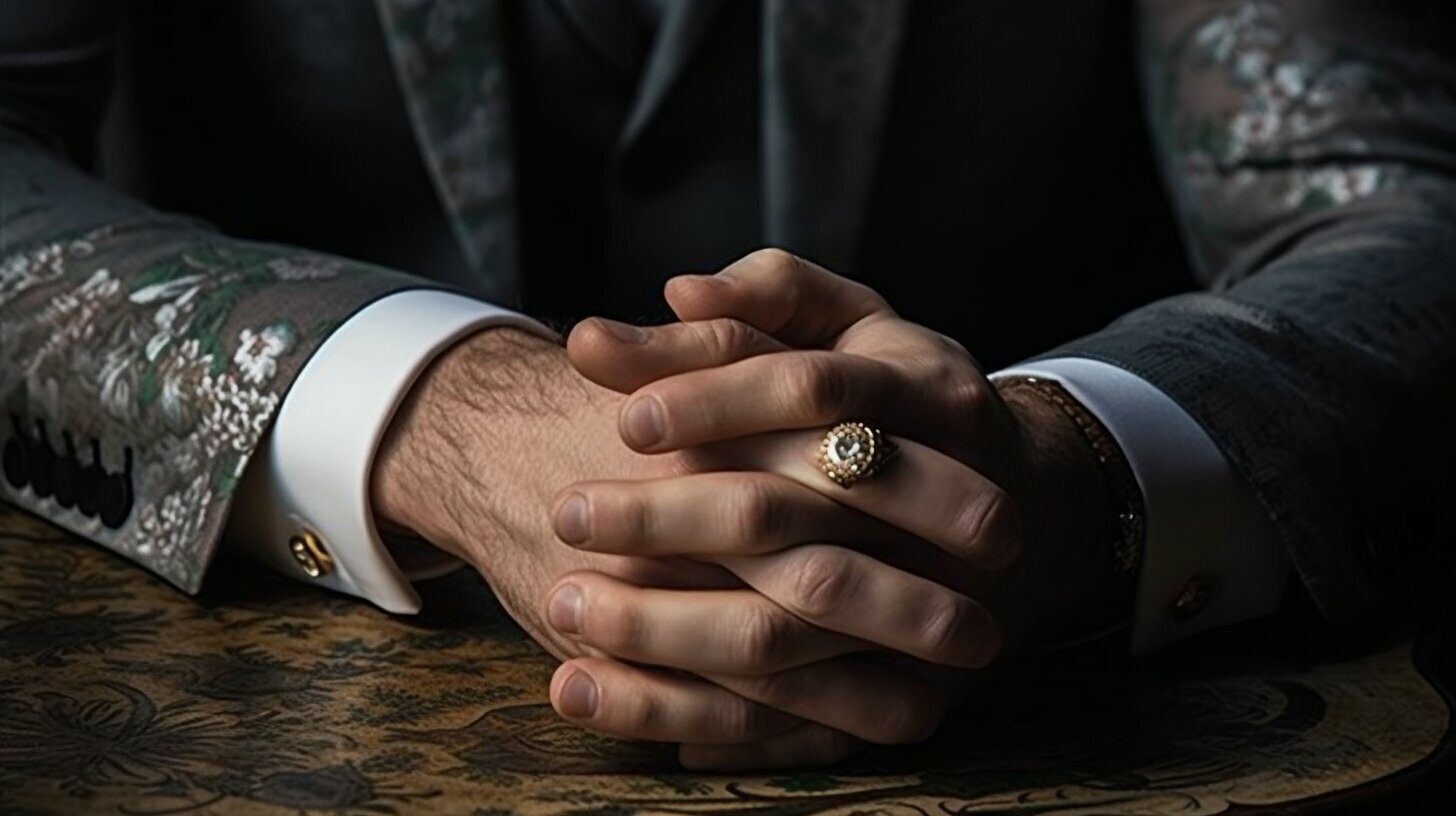Unraveling the Mystery: Why Don’t Guys Wear Engagement Rings?
The tradition of men not wearing engagement rings has deep roots in history and is influenced by cultural norms and societal expectations. Throughout the ages, engagements have often been viewed as contractual agreements, and the practice of women wearing engagement rings became more prevalent as a symbol of their commitment. However, as society evolves and we strive for equality in relationships, the idea of men wearing engagement rings is gaining traction. This shift challenges the traditional notion that only women need to display their commitment and opens up new possibilities for expressing love and commitment in relationships.
Key Takeaways:
- The tradition of men not wearing engagement rings originates from historical practices tied to contractual engagements.
- Cultural norms and societal expectations have influenced the lack of popularity surrounding male engagement rings.
- As gender roles continue to shift, more men are choosing to wear engagement rings as a symbol of their commitment.
- Men wearing engagement rings challenges the patriarchal notion that women are solely responsible for displaying commitment.
- The trend of men wearing engagement rings is gaining popularity in various countries around the world.
Historical Roots and Cultural Norms
To understand why men don’t typically wear engagement rings, we must explore the historical roots and cultural norms that have shaped this tradition. The practice of women wearing engagement rings dates back centuries, with the diamond engagement ring becoming popularized in the early 20th century. However, the same cannot be said for men.
In ancient Rome, engagements were viewed as contractual agreements between families, where the exchange of rings symbolized the upcoming union. While women were expected to wear the engagement ring as a visible sign of their commitment, men did not have the same cultural expectation. This historical perspective laid the foundation for the gendered tradition we see today.
Shifting gender roles and societal expectations play a significant role in determining whether men choose to wear engagement rings. In some cultures, men wearing jewelry, including engagement rings, has been perceived as non-traditional or even emasculating. However, as gender equality becomes more valued in relationships, couples are actively challenging these norms and redefining what it means to express commitment.
Male Engagement Ring Traditions Worldwide
“The concept of men wearing engagement rings challenges the patriarchal notion that women are the only ones who need to display their commitment.”
While the tradition of men wearing engagement rings may not be widespread, there are instances of male engagement ring customs in various countries around the world. For example, in Sweden, it is common for both men and women to wear engagement rings, emphasizing equality in their relationships. Similarly, in Argentina, men often wear a silver engagement band, symbolizing their commitment alongside their partners.
When it comes to the design and style of men’s engagement rings, options are diverse. Some men prefer traditional bands made of gold or platinum, while others opt for more unique materials like tungsten or titanium. The trend of men wearing engagement rings opens up a world of possibilities in terms of personal expression and individual style.
As societal norms continue to evolve, so too do our perceptions of gender roles and expectations. The idea that men can wear engagement rings challenges the traditional notion that commitment must be solely displayed by women. Instead, it promotes the idea of equality in relationships, where both partners can symbolize their love and commitment in their own unique ways.
Society’s Expectations and Gender Equality
Society’s expectations and perceptions of masculinity play a significant role in the lack of popularity surrounding men’s engagement rings. For centuries, the tradition of women wearing engagement rings has been deeply ingrained in cultural norms and societal expectations. The symbolism behind a woman’s engagement ring has often been associated with commitment, love, and the anticipation of marriage. However, these traditional gender roles and expectations have left little room for men to express their own commitment and devotion in a similar way.
“Men’s engagement rings challenge the notion that only women need to display their commitment.”
This lack of popularity can also be attributed to the perception of masculinity. Men wearing engagement rings may face societal judgment or criticism due to the perceived deviation from traditional gender roles. The notion that engagement rings are solely for women can reinforce the idea that men should be strong, stoic, and less inclined to demonstrate their emotional investment in a relationship. However, as gender equality becomes increasingly important in modern relationships, more couples are embracing the idea of men wearing engagement rings as a way to challenge these stereotypes and establish a sense of equality.
As the concept of gender equality continues to evolve, it is important to recognize that wearing an engagement ring is a personal choice. Men who choose to wear engagement rings are defying societal expectations and redefining what commitment means in a relationship. This shift in cultural norms not only empowers men to openly express their love and devotion, but also fosters a sense of equality and partnership between couples.
| Country | Percent of Men Wearing Engagement Rings |
|---|---|
| Sweden | 28% |
| Argentina | 15% |
| United States | 7% |
These statistics highlight the growing trend of men wearing engagement rings in various countries, including Sweden and Argentina. While the percentages may vary, they illustrate a cultural shift towards gender equality and the acceptance of men’s choice to wear engagement rings.
- Men’s engagement ring designs range from classic bands to more unique and personalized styles, allowing individuals to express their own sense of style and individuality.
- The use of alternative materials, such as titanium or tungsten, provides men with options beyond traditional gold or silver bands, adding a contemporary twist to the concept of engagement rings.
- Men’s engagement rings can also incorporate gemstones or diamonds, giving them a touch of elegance and refinement.
Conclusion
The lack of popularity surrounding men’s engagement rings can be attributed to societal expectations, perceptions of masculinity, and traditional gender roles. However, as couples strive for equality and challenge these norms, the trend of men wearing engagement rings is gaining momentum. This shift not only allows men to openly express their commitment and devotion but also symbolizes the desire for equality and partnership in relationships. By embracing this change, couples are reshaping societal expectations and redefining what it means to be engaged.
Breaking Traditions: Men Wearing Engagement Rings
As societal norms continue to evolve, an increasing number of men are challenging traditional gender roles by embracing engagement rings as a symbol of their commitment. Historically, engagement rings have been associated with women, but the rising trend of men wearing these rings is reshaping cultural perceptions and redefining what it means to be engaged.
Men’s engagement ring designs have become more diverse, offering a wide range of options to suit individual styles. From classic bands to innovative materials and unique designs, men now have the freedom to express their personal tastes and preferences. This shift in the jewelry industry reflects a growing desire for equality in relationships, where both partners are equally committed and involved.
“The concept of men wearing engagement rings challenges the patriarchal notion that women are the only ones who need to display their commitment,” says jewelry expert Sarah Thompson. “By wearing an engagement ring, men can proudly celebrate their upcoming marriage and showcase their dedication to their partner.”
While the tradition of men wearing engagement rings may still face some resistance in certain cultures, countries like Sweden and Argentina have embraced this trend. In Sweden, for example, it’s common for both partners to wear engagement rings, symbolizing their equal commitment to each other.
| Cultural Perspective | Male Engagement Ring Tradition |
|---|---|
| Sweden | Both partners commonly wear engagement rings. |
| Argentina | Men wearing engagement rings is gaining popularity. |
As couples strive for gender equality and mutual respect in their relationships, the landscape of engagement ring traditions continues to evolve. The changing societal norms encourage men to embrace their commitment openly and proudly, making engagement rings a symbol of love and partnership for both genders. This trend not only challenges conventions but also fosters a more inclusive and equal society.
Redefining Commitment: Equality in Relationships
The decision of men to wear engagement rings reflects a desire for equality and mutual commitment within relationships. As traditional gender roles continue to evolve, couples are embracing the idea that both partners should have the opportunity to symbolize their love and dedication through the wearing of an engagement ring. This shift challenges the patriarchal notion that women are the only ones who need to display their commitment, and instead promotes a more balanced and equal approach to relationships.
Across various countries, including Sweden and Argentina, the trend of men wearing engagement rings is gaining momentum. This cultural shift is a testament to the changing perceptions of masculinity and the recognition that love and commitment are not limited by gender norms. Men’s engagement rings are now available in a wide range of styles, materials, and designs, allowing individuals to express their personal taste and uniqueness.
When it comes to choosing an engagement ring, men now have the freedom to explore a variety of options. Whether they prefer a classic band made of precious metals like gold or platinum, or a more contemporary design featuring alternative materials such as titanium or tungsten, there is a growing market catering to their preferences. This expanding range of choices reflects the desire for men to have a ring that truly reflects their personality and complements their partner’s ring.
| Benefits of Men Wearing Engagement Rings |
|---|
| 1. Symbolizes equality and mutual commitment |
| 2. Challenges traditional gender roles |
| 3. Allows men to express their personal style |
| 4. Creates a sense of unity and partnership |
By wearing an engagement ring, men are not only expressing their love and devotion, but also reinforcing the idea of equality within relationships. The act of wearing a ring serves as a visible reminder of the commitment shared between partners, fostering a sense of unity and partnership. It allows couples to redefine what commitment means to them, breaking free from outdated norms and embracing their own unique journey.
Conclusion
Understanding the reasons behind why men don’t typically wear engagement rings requires consideration of historical traditions, cultural perspectives, and societal expectations, but as gender roles continue to evolve, the concept of men wearing engagement rings may see a rise in popularity.
The tradition of men not wearing engagement rings can be traced back to historical roots, such as the contractual nature of engagements in ancient Rome. Engagements were viewed as agreements between families, and only women were expected to wear rings as a symbol of their commitment. However, as the concept of gender equality gains traction in modern times, couples are redefining traditions and seeking more egalitarian relationships.
While engagement rings have traditionally been associated with women, the trend of men wearing engagement rings is gaining popularity worldwide. Countries like Sweden and Argentina have embraced this idea, challenging the patriarchal notion that women are the only ones who need to display their commitment. Men are now choosing to wear engagement rings as a symbol of their love and dedication to their partners.
The stylistic choices for men’s engagement rings are diverse, with options ranging from traditional bands to unique materials and designs. Men are embracing their individuality and personal style through their choice of engagement rings, just as women have done for centuries. This shift demonstrates a desire for equality in relationships, where both partners can express their commitment in their own unique way.
As societal norms continue to evolve, we may see a gradual shift in the perception of men wearing engagement rings. Breaking away from traditional expectations, more men are recognizing the importance of outwardly symbolizing their commitment. With a growing emphasis on equality and individuality, the concept of men wearing engagement rings may become more widely accepted and celebrated.
FAQ
Why don’t guys wear engagement rings?
The tradition of men not wearing engagement rings can be traced back to historical roots, such as the contractual nature of engagements in ancient Rome. However, as societal norms shift and couples value equality in their relationships, more men are choosing to wear engagement rings as a symbol of their commitment.
What are the cultural norms around male engagement rings?
Engagement rings have traditionally been associated with women, but the trend of men wearing engagement rings is gaining popularity in various countries, such as Sweden and Argentina. The stylistic choices for men’s engagement rings are diverse, ranging from traditional bands to unique materials and designs.
Why do some people believe that men shouldn’t wear engagement rings?
The idea of men wearing engagement rings challenges the patriarchal notion that women are the only ones who need to display their commitment. Some people may hold onto traditional beliefs that associate femininity with wearing jewelry, but as societal attitudes towards gender roles evolve, more individuals are embracing the idea of equality in relationships and engagement ring choices.






